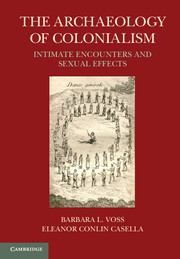Book contents
- Frontmatter
- Contents
- List of Illustrations
- List of Tables
- List of Contributors
- One Intimate Encounters
- Two Sexual Effects
- Section I Pleasures and Prohibitions
- Section II Engaged Bodies
- Section III Commemorations
- Twelve Life and Death in Ancient Colonies
- Thirteen Reading Gladiators’ Epitaphs and Rethinking Violence and Masculinity in The Roman Empire
- Fourteen Monuments and Sexual Politics in New England Indian Country
- Fifteen Gender Relations in A Maroon Community, Palmares, Brazil
- Section IV Showing and Telling
- Conclusion
- Index
- References
Fourteen - Monuments and Sexual Politics in New England Indian Country
from Section III - Commemorations
Published online by Cambridge University Press: 05 June 2012
- Frontmatter
- Contents
- List of Illustrations
- List of Tables
- List of Contributors
- One Intimate Encounters
- Two Sexual Effects
- Section I Pleasures and Prohibitions
- Section II Engaged Bodies
- Section III Commemorations
- Twelve Life and Death in Ancient Colonies
- Thirteen Reading Gladiators’ Epitaphs and Rethinking Violence and Masculinity in The Roman Empire
- Fourteen Monuments and Sexual Politics in New England Indian Country
- Fifteen Gender Relations in A Maroon Community, Palmares, Brazil
- Section IV Showing and Telling
- Conclusion
- Index
- References
Summary
Introduction
On September 21, 1883, the Rhode Island Historical Society dedicated a boulder monument to Canonicus, a seventeenth-century sachem (or “chief”) of the Narragansett, in the city of Providence's oldest public cemetery (Figure 14.1). In a ceremony filled with European Americans’ speeches, poems, and patriotic songs, a Narragansett man had the dubious honor of unveiling the monument, and a little Narragansett girl presented a bouquet of flowers to the Indian Commissioner. Neither is reported to have said a word.
For members of the Society with antiquarian tastes and romanticized views about the Native American past, the dedication fulfilled a plan to commemorate “the friendly deeds of the sons of the forest by erecting to each a simple and inexpensive monument” that had lingered almost for forty years (Rhode Island Historical Society 1875: 68). The idea was proposed when opinions linking Native American decline and assimilation and the nation's historic destiny were gaining popularity across the United States. With predictions about vanishing Native Americans disappearing into the melting pot seeming increasingly undeniable, European Americans were assured that the time for implementing the plan for commemorating the “sons of the forest” had come. Not surprisingly, the monument envisioned for Canonicus, the most illustrious “son of the forest” considered worthy of commemoration, appeared on the landscape only after Rhode Island declared the Narragansett people “extinct” and terminated its formal relations with the tribe. Nearly two hundred years after devastating losses in a bitter conflict between Indians and colonists called King Philip's War (1675–1676) and the insults of sustained colonialism, the Narragansett had become in the eyes of many European Americans so dwindled in number, divorced from place, and diluted by blood that they ceased to exist as a tribe.
- Type
- Chapter
- Information
- The Archaeology of ColonialismIntimate Encounters and Sexual Effects, pp. 232 - 251Publisher: Cambridge University PressPrint publication year: 2011



